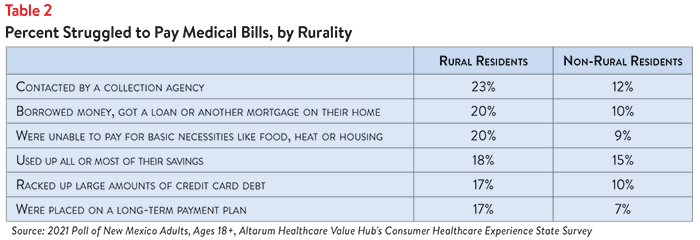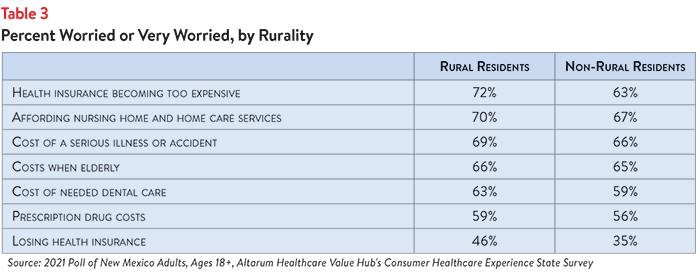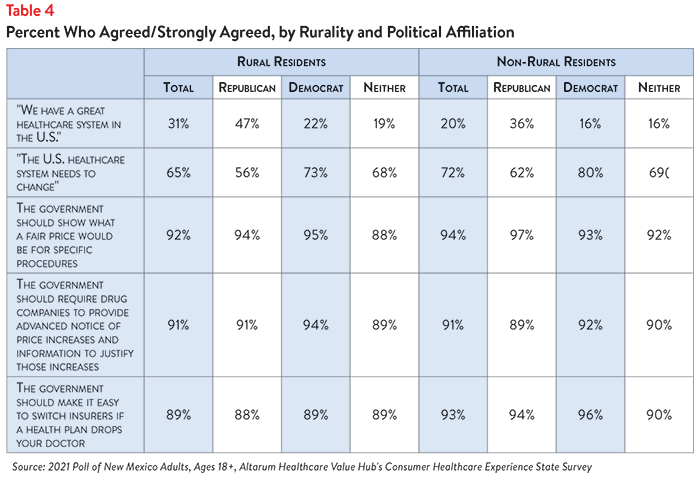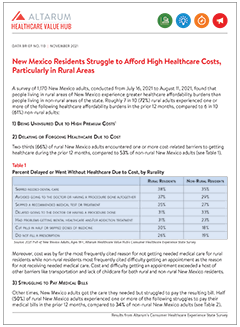New Mexico Residents Struggle to Afford High Healthcare Costs, Particularly in Rural Areas
A survey of 1,170 New Mexico adults, conducted from July 16, 2021 to August 11, 2021, found that people living in rural areas of New Mexico experience greater healthcare affordability burdens than people living in non-rural areas of the state. Roughly 7 in 10 (72%) rural adults experienced one or more of the following healthcare affordability burdens in the prior 12 months, compared to 6 in 10 (61%) non-rural adults:
1) Being Uninsured Due to High Premium Costs1
2) Delaying or Forgoing Healthcare Due to Cost
Two-thirds (66%) of rural New Mexico adults encountered one or more cost-related barriers to getting healthcare during the prior 12 months, compared to 53% of non-rural New Mexico adults (see Table 1).

Moreover, cost was by far the most frequently cited reason for not getting needed medical care for rural residents while non-rural residents most frequently cited difficulty getting an appointment as the reason for not receiving needed medical care. Cost and difficulty getting an appointment exceeded a host of other barriers like transportation and lack of childcare for both rural and non-rural New Mexico residents.
3) Struggling to Pay Medical Bills
Other times, New Mexico adults got the care they needed but struggled to pay the resulting bill. Half (50%) of rural New Mexico adults experienced one or more of the following struggles to pay their medical bills in the prior 12 months, compared to 34% of non-rural New Mexico adults (see Table 2).
High Levels of Worry About Affording Healthcare in the Future
Large shares of both rural and non-rural residents reported high levels of worry about affording healthcare in the future. A slightly higher percentage of rural residents (83%) reported being “worried” or “very worried” about one of more of the following topics, while 78% of non-rural residents reported being “worried” or “very worried” (see Table 3).
Dissatisfaction with the Health System and Support for Change
In light of these healthcare affordability concerns, it is not surprising that both rural and non-rural New Mexico residents reported being dissatisfied with the health system. Just 31% of rural and 20% of non-rural residents agreed or strongly agreed that “we have a great healthcare system in the U.S.,” while 65% of rural and 72% of non-rural residents agreed or strongly agreed that “the system needs to change.”
New Mexico adults also see a role for themselves in addressing healthcare affordability problems. Both rural and non-rural residents reported actions they have already taken, like researching the cost of a drug beforehand (59% of rural residents and 58% of non-rural residents), as well as actions they should be taking. Sixty-three percent of rural adults and 68% of non-rural adults believe that taking better care of their personal health is one of the top things they can do personally to address affordability. Additionally, many said they would switch from a brand name to an equivalent generic drug if given a chance (77% of rural residents and 80% of non-rural residents).
The high burden of healthcare affordability, along with high levels of support for change, suggest that elected leaders and other stakeholders need to make addressing healthcare costs a top priority. Moreover, the current COVID crisis is leading state residents to take a hard look at how well health and public health systems are working for them, with strong support for a wide variety of actions. Annual surveys can help assess whether or not progress is being made.
Note
1. We received too few responses at the regional level to provide a reliable estimate for this statistic, however these respondents are represented in the overall “burdened” population.
For state-wide data, see www.healthcarevaluehub.org/New-Mexico-State-Survey.










